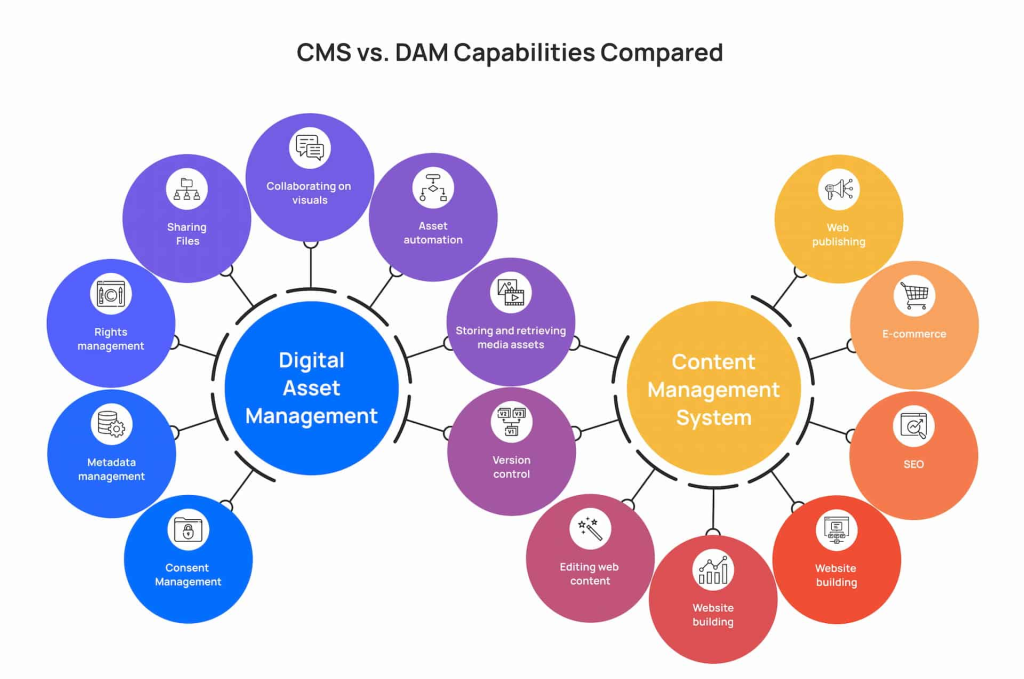
In today’s digital-first world, businesses are constantly managing a vast array of media files—images, videos, documents, and more. The need to store, organize, and retrieve these digital assets efficiently is crucial to streamline workflows and improve productivity. This is where Digital Asset Management (DAM) systems come into play. But when choosing a DAM tool, the decision often boils down to one question: Should your team choose an open-source solution or opt for a paid tool?
Both open-source and paid DAM tools offer distinct advantages and challenges. In this blog, we’ll explore the key differences between these two types of DAM solutions to help you decide which one best suits your team’s needs.
Understanding Digital Asset Management (DAM)
A Digital Asset Management system is a software solution that enables businesses to organize, store, manage, and distribute their digital content. Whether it’s images, videos, audio files, or documents, a DAM tool ensures easy access, quick retrieval, and efficient distribution. This is essential for marketing teams, content creators, and SEO professionals who rely on the effective management of digital media to drive their business objectives.
Open Source DAM Tools: The Pros and Cons
Open-source DAM tools are freely available software solutions that allow businesses to modify and customize the source code. These tools are often maintained by a community of developers, and although they may come with basic features, they can be a great option for teams that have technical expertise and a limited budget.
Advantages of Open Source DAM Tools
- Cost-Effective Solution
The most significant advantage of open-source DAM tools is that they are typically free to use. For small businesses or startups operating on a tight budget, these tools offer a cost-effective solution to manage digital assets without hefty upfront investments. - Customization & Flexibility
Open-source DAM tools provide the flexibility to modify the source code according to your team’s specific requirements. Whether you need custom features, integrations with other systems, or specific workflows, open-source tools allow you to tailor the software to fit your business needs. - Community-Driven Support
With open-source software, you benefit from the contributions of a large and active community. While this may not provide immediate professional support, you can find plenty of forums, tutorials, and user-generated content to troubleshoot or improve your system. - No Vendor Lock-In
One of the appealing aspects of open-source software is the freedom from vendor lock-in. You’re not tied to a particular vendor’s ecosystem or pricing model, giving you greater control over your software.
Disadvantages of Open Source DAM Tools
- Limited Support & Maintenance
While community support is helpful, it can’t match the level of support offered by paid solutions. Without dedicated customer service or professional assistance, resolving complex issues can be challenging and time-consuming. - Technical Expertise Required
Open-source tools are typically designed for developers, which means non-technical teams may find it difficult to set up, customize, and maintain these systems. Without in-house technical expertise, companies might struggle with implementation and ongoing management. - Security Risks
Open-source tools can sometimes pose security risks if not regularly updated or properly configured. Unlike paid tools that provide ongoing patches and updates, open-source tools rely on the community to identify and fix vulnerabilities.
Paid DAM Tools: The Advantages & Drawbacks
Paid DAM tools offer an out-of-the-box solution with more robust features, dedicated support, and continuous updates. These tools are popular among businesses that prioritize convenience, reliability, and scalability over cost.
Advantages of Paid DAM Tools
- Comprehensive Feature Set
Paid DAM tools often provide a wide range of features, including advanced search functionalities, automatic metadata tagging, integrations with other enterprise systems, and powerful analytics. These features make it easier for teams to manage, track, and utilize digital assets effectively. - Professional Support
One of the key benefits of paid DAM solutions is the availability of professional support. With dedicated customer service teams, businesses can quickly resolve issues and get expert guidance on optimizing their use of the system. - Regular Updates & Security Enhancements
Paid tools are regularly updated to introduce new features and fix security vulnerabilities. With the assurance of consistent updates, your team can rely on the tool to remain secure, efficient, and capable of handling new challenges as your business evolves. - Scalability
As your business grows, so does the need to scale your DAM system. Paid solutions are often designed with scalability in mind, ensuring that they can handle large amounts of digital assets and support an expanding team or content library.
Disadvantages of Paid DAM Tools
- Ongoing Costs
The most obvious downside of paid DAM tools is the cost. Subscription-based pricing models can result in recurring expenses, and the initial cost of a one-time payment can be high for businesses with limited budgets. - Limited Customization
Unlike open-source solutions, paid DAM tools may not offer the same level of customization. Businesses that require a specific workflow or integration may find themselves limited by the predefined features of the software. - Vendor Lock-In
With a paid tool, there is a risk of being locked into a vendor’s ecosystem. If you want to switch to a different solution in the future, migrating your data and assets could be costly and time-consuming.
Which DAM Tool is Right for Your Team?
When deciding between open-source and paid DAM tools, several factors need to be considered:
- Budget: If cost is a major concern and you have the technical expertise in-house, an open-source tool might be the best choice. However, if you can afford the ongoing subscription or upfront fees, a paid solution might be better in the long run.
- Customization Needs: Open-source tools offer greater flexibility for customization, making them ideal for teams that need a tailored solution. On the other hand, if you need a robust, ready-to-use system, a paid tool with predefined features might be the better option.
- Support: For businesses that lack technical resources, paid DAM tools offer professional support, ensuring that any issues are quickly resolved. Open-source tools, while community-driven, may require more technical involvement.
- Scalability & Future Growth: Paid solutions often offer better scalability, which can accommodate growing teams and digital asset libraries. If your business is expecting rapid growth, a paid DAM tool might be more appropriate.
Why Wizbrand Stands Out as a Paid DAM Solution
Wizbrand is an excellent example of Best Digital Asset Management Software, providing businesses with a comprehensive and scalable solution for managing digital assets. As one of the Best DAM Tools in the world, Wizbrand combines powerful features, seamless integrations, and professional support to ensure that your team can manage, collaborate on, and distribute content efficiently.

In addition to offering a robust DAM system, Wizbrand also integrates with SEO Management Software, helping marketing teams optimize digital assets for better visibility on search engines and ensuring that assets contribute to business growth.
Conclusion
The decision between open-source and paid DAM tools depends on your team’s needs, budget, and technical expertise. Open-source tools can be an excellent option for businesses with limited resources and technical know-how, while paid DAM solutions like Wizbrand offer comprehensive features, dedicated support, and scalability. Explore Wizbrand’s platform today to experience a powerful DAM solution that can elevate your digital asset management and improve your team’s productivity.